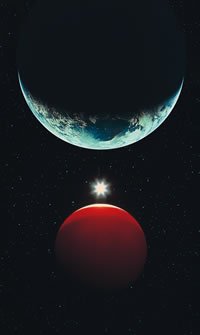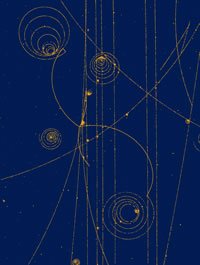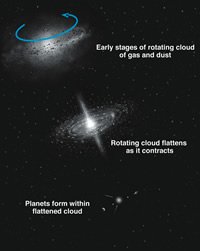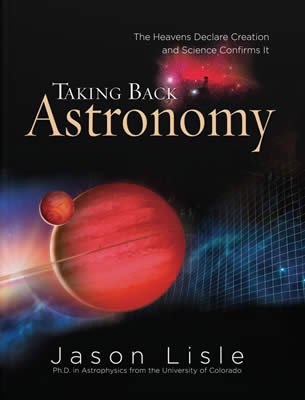
Chapter 4
The Bible and Modern Astronomy, Part 1
Aside from the issue of the age of the universe, there are several other matters where the majority of astronomers today disagree with a straightforward reading of the Bible. In this chapter, we will investigate these differences, and we will see that the evidence very much supports the Genesis record of creation. We will explore the concept of naturalism and examine the philosophic and scientific problems with it. We will examine the question of the uniqueness of the earth and the concept of extraterrestrial “alien” life.
Naturalism Versus Supernaturalism
Perhaps the most obvious difference between the biblical view and the secular view lies in the first verse of the Bible, “In the beginning God created. . . .” This stands in stark contrast to the secular teaching of a universe which spontaneously formed in a big bang. The big bang, and secular ideas about the formation of galaxies, the solar system, etc., are naturalistic explanations of origins. They are atheistic in nature. This is not to say that everyone who holds these views is necessarily an atheist, but these naturalistic formation scenarios attempt to explain the creation of the universe and things within it (galaxies, stars, planets, etc.) without God. None of the astronomy textbooks I have used in my undergraduate education or doctoral program give credit to God for the creation of the universe or anything within it. All events are described in terms of what can be explained within the laws of nature—nothing beyond nature is allowed. This is naturalism.
The Bible is super-naturalistic. The Bible makes it clear that God (either directly or indirectly) made everything that was made (John 1:3). God is “outside” of the physical universe; He is not bound by it. The Christian worldview is therefore supernatural in nature. The Christian claims that the processes which created the universe are not the processes that exist within it.
The Philosophy of Naturalism
Naturalism is extremely popular in scientific circles today. In fact, many scientists even equate science with naturalism. After all, science depends on the fact that there are laws of nature which the universe consistently obeys. Take gravity, for example. If I drop a pen, I know it will fall down at a given acceleration because of the well-known law of gravity. A naturalist might argue that if there is a God who constantly intervenes (by, for example, making my pen float, or fall up, etc.), then how would we ever learn about gravity? Experimentation would be pointless since we might get a different result every time. We would never know if we were learning something about the universe, or witnessing a miracle. Therefore, the naturalist concludes, science requires naturalism.

Christ Walks on Water

Resurrection of Christ
This kind of argument might be a reasonable objection to a haphazard god who is inconsistent and whimsical. However, this is not the biblical God. The God of Scripture does not arbitrarily suspend the laws of nature which He created. Certainly God can bend, change, suspend, or reverse the laws of nature—and has done so on special occasions for special purposes (for example, Christ’s walking on the water and the Resurrection itself ). The laws of nature were created by God and depend on God’s sustaining power for their continued existence (Hebrews 1:3). Clearly God is not “bound” by them, as we are. Many of the miracles recorded in the Bible seem to be special cases where God has worked outside the “normal” operation of the universe. However, these miracles are (by definition) exceptions and therefore rare. Primarily, the Lord accomplishes His will by upholding the laws of nature which He created, not by suspending them. Another way of putting it might be that the operation of “natural law” is God’s normative way of working.
Both the Christian and the naturalist agree that there are laws of nature which the universe “obeys” (i.e., which describe the consistent, predictable behavior of things) and that scientific experimentation can be used to probe these laws. Therefore, it is indeed possible to study and understand the universe in the Christian worldview. In fact, Christianity provides the basis for such scientific research.
The Christian expects the universe to obey laws because God created those laws—the “ordinances of heaven and earth” (Jeremiah 33:25). The creationist expects that the laws of nature that applied yesterday will apply in the future as well; this is because God is consistent (Malachi 3:6) and does not arbitrarily change His mind (Numbers 23:19). We expect the universe to be understandable, because God created it and He created us with the ability to reason (Isaiah 1:18) and understand. However, the naturalist cannot account for these properties of the universe. What reason does he have for expecting the universe to be consistent and predictable? Why should a naturalist be able to assume that the same laws that apply here on earth also apply on, for example, the surface of the star Alpha Centauri? Applying such assumptions has been overwhelmingly successful, but they are not assumptions that arise out of naturalism, but from the Bible.
So, the objection that science and knowledge are impossible without a belief in naturalism actually backfires on the naturalist. If the universe had not been designed by God, then why should it obey any laws of nature? Where did the laws of nature come from, and why do they obey logical mathematical relationships? If our brains are merely the result of a random sequence of accidental mutations, then why should we think that they can determine truth? A brain is merely a collection of electrochemical interactions which conveyed some sort of survival value in our past—in the secular scenario. There is no reason to think we can reason if naturalism were true, so, we see that the naturalist is unable to account for science and knowledge within his own worldview. He must borrow creationist ideas (that laws of nature exist and are understandable, etc.) in order to do science.
It is also crucial to point out that the origin of the universe is a different issue from the current operation of the universe. The naturalist blindly assumes that the universe was caused by the kinds of processes we see operating within the universe today.1 Of course, there is no logically compelling reason to believe this, and it would be absurd to assume that this necessarily applies to anything else. For example, a telescope operates by reflecting and refracting light to a focal point, but the telescope was not created by this process.
The Bible makes it abundantly clear that the universe was supernaturally created by God. Genesis 1 specifically lists a number of astronomical objects which were made by the Lord; He made the heavens,2 the earth (Genesis 1:1), the sun, the moon, and the stars also (Genesis 1:14–16). This means that galaxies were created supernaturally (since they are comprised of stars), and the other planets are as well (since planets are “stars” in the biblical nomenclature).3 These things were supernaturally created, and therefore, seeking a naturalistic explanation for them (as many secular astronomers do) is an exercise in futility. We would therefore expect some scientific problems in the naturalistic explanations for the origins of stars, the planets, and the universe, and this is exactly what we find.
A Few Scientific Difficulties for Naturalists
Since secular ideas of the origin of the universe are based on a faulty premise (naturalism), they abound with scientific problems and inconsistencies. An exhaustive discussion of the scientific problems with naturalistic ideas on the origin and evolution of the universe, stars, and planets would take volumes. Let us examine just a few of these.
Regarding the (big bang) naturalistic attempt to explain the origin of the universe, there is a serious issue called the baryon number problem—the problem of the missing antimatter (see in-depth box). Stated concisely, if the big bang were true, it should have produced antimatter (a substance like ordinary matter but with the charges of the particles reversed). In fact there should be as much antimatter in the universe as ordinary matter—yet there is virtually none. This is a fatal problem for the big bang. The almost complete absence of antimatter in the universe testifies to its supernatural origin.
Solar System Formation
Secular models of solar system formation have also come up short. The earth, moon, sun, and all the planets have supposedly formed from a collapsing nebula—a cloud of hydrogen and helium gas. The model is upheld by secular astronomers because it can account for some of the properties of the solar system. One such property is the fact that the small rocky worlds (Mercury, Venus, Earth, and Mars) orbit close to the sun, whereas the giant gas planets (Jupiter, Saturn, Uranus, and Neptune) orbit farther away (see creation in-depth box). This was therefore expected to be a general trend of solar systems. Thus, planets orbiting other stars can serve as test cases for the standard model of solar system formation.
We have now discovered over 150 planets orbiting other stars. Contrary to the expectations of the secular model of solar system formation, most of these extra-solar planets are large giant gas worlds that orbit very close to their star—in many cases closer than Mercury orbits the sun. This is a devastating blow to secular solar system formation scenarios. However, the diversity of these solar systems is consistent with the creative variety God has demonstrated throughout the cosmos.
Star Formation

Earth, Moon, and the sun
Although virtually all secular astronomers believe that stars form spontaneously, the physics behind this alleged process is riddled with difficulties. According to the standard model of star formation, stars form from a collapsing nebula. However, when gas is compressed, it heats up.4 This higher temperature creates extra pressure which resists further compression. The collapse would have a tendency to stop before the star ever formed. Furthermore, a collapsing cloud would spin faster as it collapsed.5 This is much the same way a skater spins up as she pulls her arms in. As the cloud spins faster, it becomes increasingly difficult to pull material in further: much as weights held at arm’s length are difficult to pull closer when one is spinning. Even if the star were able to form by pulling in the material, it would be spinning extremely rapidly. A small percentage of stars do spin rapidly,6 but most do not. The sun takes about 25 days to rotate once at its equator.7
There is also a problem with magnetic fields. The intrinsic (weak) magnetic field of the collapsing nebula would become intensified as the cloud collapsed; the process “concentrates” the magnetic field. The magnetic field would then resist being compressed further—much like trying to push two magnets together when their like poles are facing each other. Gas pressure, angular momentum, and magnetic fields all work against the possibility of a condensing star. Clearly, the secular view that stars can form naturalistically has some serious problems. From a creationist point of view, stars need not form at all. God made the stars (Genesis 1:14–16) during the creation week; they were supernaturally created.
Secular astronomers hope that future evidence will resolve these serious scientific problems, but not having enough evidence is not the real issue; it’s the interpretation of existing evidence that is the problem. With these severe scientific problems (only a few of which have been discussed), should we not at least consider the possibility that the naturalistic worldview is wrong? This incorrect worldview has led to incorrect interpretations of the evidence, which then require further conjectures to allow the evidence to fit within the defective worldview. When we start from a biblical worldview, we find that none of the above issues are problems. On the contrary, they are assets. The seamless blend of uniformity and diversity that we observe in the created universe is a mark of the God of the Bible.
The Unique Earth
We now move on to some other topics where the majority of astronomers are in opposition to a biblical worldview. A very significant point of conflict between the secular view of the universe and the biblical view has to do with the uniqueness of the earth. In the secular view, the earth is (in a sense) “just another planet,” albeit one where the conditions were lucky enough for life to form and evolve. The naturalist believes that the earth, along with the rest of the universe, is just a happy accident. It is one planet among innumerable billions in our galaxy—with other galaxies having billions of planets of their own. Most secular astronomers believe that many other “earths” exist in the universe. If we assume that our planet is an accident of nature, and that billions times billions of other planets have also formed as accidents of nature, then surely some of these are bound to come out the same way earth did.
The Bible teaches the contrary: the earth is special. Earth is unique among all the worlds that the Lord created. The description of creation as recorded in Genesis 1 makes this abundantly clear. Five of the six days of creation are spent creating and forming the earth and the life on it. Only one day is spent creating the other objects in the universe. Undoubtedly, the earth is different.
In fact, the earth is three days older than any of the other planets and stars in the universe.8 The earth was made on the first day of creation; God made it in the beginning (Genesis 1:1). The lights in the sky were made on the fourth day of creation. These lights are the sun, moon, and stars (both the “true” stars and the “wandering stars”—planets). Perhaps the Lord created the earth first to show its special significance in His divine plan.
Clearly, other planets do exist. There are several other planets in our own solar system besides earth, and astronomers have detected quite a number of planets orbiting other stars, and yet, our ability to detect extra-solar planets is still quite limited. It therefore seems very likely that there are countless billions of planets which have yet to be detected, but these planets are not merely accidents of nature. God created all these worlds for His pleasure (Revelation 4:11) and to declare His creative wisdom and glory to us. Since the other planets serve a different purpose than the earth, we expect that the planets will be different in nature than the earth. Science has certainly confirmed this biblical expectation.
Science Confirms a Unique Earth

Martian landscape

The other planets in our solar system, as well as all extra-solar planets, are creatively designed. They share some similarities with the earth, but are unlike the earth in overall properties, since their purpose is different. Consider Mars, which may be the most “earthlike” planet next to the earth itself. Mars has a solid, rocky surface with mountains, volcanoes, canyons, dried riverbeds, polar ice caps, a rotation period of just over 24 hours, a bright daytime sky, seasons, an atmosphere, and even weather. However, unlike earth, Mars has a pink sky, a much thinner atmosphere of carbon dioxide, large concentrations of frozen carbon dioxide (“dry ice”), two (very small) moons, only about one-third of the earth’s surface gravity, no liquid water on its surface, and perhaps most significantly—no known life.
Of all the known planets, Venus most closely matches the earth in size. It is a solid planet with a surface gravity comparable to that of the earth, but before you plan a vacation there, you may want to consider the many differences. Venus has a thick, crushing atmosphere of carbon dioxide with clouds of sulfuric acid that enshroud the planet. The surface temperature is about 900 degrees Fahrenheit (480ºC), and there are no seasons, since Venus is not significantly tilted relative to its orbital plane. Venus rotates “backward” (the sun would rise in the west) and takes 243 (earth) days to rotate once. It is clearly not designed for life, but it does declare God’s glory. Those same clouds of acid (which would be lethal on an inhabited world) are highly reflective. They make Venus one of the brightest and most beautiful objects in our night sky. Venus can often be seen as the brilliant “evening star” standing in the west just after sunset or as the “morning star” in the east just before sunrise.

Size comparison of the terrestrial planets

Size comparison of the giant gas planets
The planet Mercury is more like the moon than the earth. Mercury is about one-third the size of the earth and has no appreciable atmosphere. It is essentially a large rock in space. A cratered, barren world, Mercury stands in stark contrast to the richness and beauty of the earth. At the other end of the line lies distant Pluto. This tiny world has an average temperature of about 50 K (-369ºF, or -223ºC) since it is nearly 40 times farther away from the sun than the earth is. The sun would appear over 1,000 times fainter as seen from Pluto than it does from the earth. [Web editor’s note: since this chapter was published, Pluto has been “demoted” and is no longer considered to be a planet.]
Then there are the giant gas planets: Jupiter, Saturn, Uranus, and Neptune. These worlds are amazing and beautiful, but are very different from the earth. Gas giants do not have a solid surface upon which a person could stand. They are comprised primarily of hydrogen and helium gas (like stars), and they have other compounds such as methane and ammonia. Uranus and Neptune are each about four times larger than the earth in diameter, whereas Saturn is nine times (and Jupiter about 11 times) the earth’s diameter. I have thoroughly enjoyed viewing these planets through telescopes. They are dynamic—particularly Jupiter and Saturn. The outer planets demonstrate God’s inventiveness, but clearly they are very different from the earth. The extra-solar planets we have discovered so far appear to be much like these gas giants—large balls of hydrogen gas. They are beautifully made, but not like the earth.
The earth is unique among known worlds for a number of reasons. For example, the earth is the only planet known to have plate tectonics. The earth’s crust appears to be divided into plates which can move relative to each other. This is very significant because the mechanism of plate tectonics is thought to be largely involved in the global Flood described in Genesis 6–8. God used this flood to judge the sin of mankind (Gen. 6:11–13). Since the other planets did not need to be flooded, it stands to reason that they would not need plate tectonics.
Liquid water exists in abundance on earth; this is an extremely unusual condition. Although water molecules are fairly common in the universe, they are generally found in the form of vapor or ice—not liquid. The fact that 70 percent of the earth’s surface is covered with water is extremely exceptional. The earth has an abundance of free oxygen—no other known planet has an atmosphere like this.
Additionally, the earth is at just the right distance from the sun for life to be possible. Indeed, many of earth’s characteristics are specially designed for life. This is exactly what we would expect from the Bible. God formed the earth to be inhabited (Isaiah 45:18). That is the earth’s primary purpose. The purpose of the rest of the stars and planets in the universe is different. The rest of the universe was made to divide the day from the night, to be for signs, seasons, days, and years (Genesis 1:14), to give light upon the earth (Genesis 1:15), and to declare God’s glory (Psalms 19:1) for His pleasure (Revelation 4:11). The Bible teaches, and science confirms, that the earth is unique.
Creation In-depth
Where’s the Antimatter?
One of the many scientific problems with the big-bang notion is called the “baryon number problem.” In the big-bang scenario, the universe starts out infinitely small, and infinitely hot, in a point called a “singularity.” All the energy in the universe, and even “space itself,” is contained in this point. The point rapidly expands like a balloon and the energy cools as it is dispersed. The energy forms matter—hydrogen and helium gas. It is this gas which allegedly condenses to form stars and galaxies. Virtually every step in this conjectured process is riddled with problems that are indicative of the big bang’s dismal inadequacy as a scientific model.9 Let’s highlight one of these problems involving the conversion of energy to matter.
Energy can indeed be transformed into matter. This can be done in a laboratory. However, such reactions always produce an equal amount of a substance called “antimatter.” Each class of particle of matter has a corresponding anti-particle. Antimatter is identical to ordinary matter in virtually all respects except one: the charge of the particle is reversed. So, whereas a proton has a positive electrical charge, its antimatter counterpart, the “anti-proton,” has a negative charge. Likewise, electrons are negatively charged, but an anti-electron (also called a “positron”) has a positive charge. As far as we know, it is impossible to create matter from energy without creating an exactly equal amount of antimatter. This is what laboratory science has shown us.

If the big bang had actually happened, it too would have produced an equal amount of antimatter. Therefore, the universe today should have an equal amount of matter and antimatter. But it doesn’t. The universe is made almost entirely of matter. This is no slight imbalance; it is a huge problem. It is estimated that the universe contains 1080 atoms (that’s a one followed by 80 zeros). Each of these has a nucleus made of protons (and sometimes neutrons). Protons and neutrons are “baryons.” There are ubiquitous baryons in the universe, and yet there are virtually no anti-baryons to be found!
Big-bang supporters have come up with an idea to try and save the big bang from this baryon number problem. They have proposed that on extremely rare occasions energy can produce matter only—with no antimatter produced as a by-product. Indeed, there are a number of variant speculations in physics that rely on this notion to solve the problem of the missing antimatter, but, of course, this idea does not rely on the results of observational science. Observations have shown that matter and antimatter are always produced in pairs; we have never seen one produced without the other. As usual, the naturalist must rely on conjectures that are inconsistent with observations. The baryon number problem remains a serious defect in the big-bang model.
This problem for the big bang is actually a design feature for biblical creation. When particles and anti-particles touch, they destroy each other and release enormous amounts of energy. If God had made the universe with equal amounts of matter and antimatter (as physics requires for a natural origin), then the matter in the universe would have been destroyed by any contact with antimatter, releasing devastating amounts of dangerous radiation. The universe contains virtually matter only because it was supernaturally designed and created by God.
Extra-solar Planets

In the secular model of solar system formation, a cloud of hydrogen and helium gas begins to shrink and heat up. Much of the nebula collapses down to become the proto-sun which is surrounded by a disk of gas and dust. The dust grains collect to form gravitational seeds of planets which grow larger as they absorb more gas and dust. Upon reaching critical density, the sun begins fusing hydrogen gas and the radiation drives away the hydrogen gas envelope surrounding the terrestrial planets. Since the radiation is weaker at greater distances from the sun, it is insufficient to drive away the hydrogen atmospheres of the outer planets. The model thus explains why the inner planets are small and rocky, and the outer planets are enormous giant gas worlds. Since other solar systems are thought to have formed in the same way, it was expected that they too would have small terrestrial planets orbiting close to the star, and large gas giants orbiting farther away.
We now know that this is not the case. Through various methods, astronomers have now discovered a number of planets orbiting other stars. In most instances, the planet has been detected by indirect means. Astronomers are able to measure the “wobble” that planets induce on the star they orbit; the orbit of the planet can then be deduced, even though the planet itself is not visible. The minimum mass of the planet can be estimated by the severity of the wobble. In a few known cases, the planet’s orbit is aligned such that the planet passes directly in front of the star—blocking a small fraction of the star’s light. These transiting cases allow us to know the size of the planet as well as its actual mass. More recently, extra-solar planets have actually been observed directly.
Virtually all of the extra-solar planets discovered so far go against the secular prediction. They are large gas giants which orbit very close to their star. They are often referred to as “hot Jupiters.” To be fair, most of the techniques used to discover these planets could only detect hot Jupiters. Nonetheless, the fact that such systems exist in abundance is powerful evidence against the secular model.
As we might expect, secular astronomers have attempted to adjust their ideas of solar system formation to allow for the existence of hot Jupiters. One currently popular idea suggests that these solar systems formed so as to be much as our solar system is today—with gas giants far away from the star. Then the gas giants supposedly “migrated” from their original position to their current location close to their star. Unfortunately (for the naturalists), this scenario has many difficulties of its own. There are issues of how to stop the planet from crashing into the star once the migration begins. There is also the difficulty of explaining why this apparently did not happen in our own solar system. Rather than tacking on additional speculations to explain why the evidence does not fit the naturalistic expectations, might we consider the possibility that biblical creation is the correct explanation? These extra-solar planets are in line with the biblical worldview. God has created a diverse universe with many types of solar systems for His pleasure, and to declare His glory as they are discovered (Psalms 19:1).
Taking Back Astronomy
Dr. Lisle communicates the truths of creation and the fallacies of evolution with authority and enthusiasm. In this richly illustrated book, Lisle debunks the most widely accepted teachings about the idea of evolution. Readers are given solid answers to many questions, including the speed of light, the big bang, extraterrestrials, the reliability of the Bible regarding astronomy, and more.
Read Online Buy BookFootnotes
- This is because there is no “outside” or “beyond” the universe in the naturalist’s view.
- In this context, “heavens” probably refers to the dimensions of the universe—the “fabric” of spacetime. The heavens would have been empty (at least of stars) for the first three days, since the stars were made on day 4.
- Biblically, planets are classified as “stars”—they are “wandering stars” and are referred to as such in Jude 1:13. The word “planet” means wanderer.
- This follows from the ideal gas law. In physics notation, the law is written as P = nkT where P is pressure, n is the number density of particles, k is the Boltzmann constant, and T is temperature in Kelvin.
- This follows logically from the conservation of angular momentum.
- T Tauri class stars, for example.
- The sun spins even more slowly at its poles (taking over 30 days to rotate once); thus, it is constantly “twisting” itself. This differential rotation would not be possible for a solid object, but since the sun is gaseous, it does not need to rotate at the same rate at all latitudes.
- This difference in age is as measured by clocks on earth. Einstein’s theory of relativity has shown that time is not constant; time can flow at different rates in different regions of the universe. Time in the Bible must be from earth’s perspective, since it is defined using day and night—a rotation of the earth.
- See also Dismantling the Big Bang: God’s Universe Rediscovered, by Alex Williams and John Hartnett (Green Forest, AR: Master Books, 2005).
Recommended Resources

Answers in Genesis is an apologetics ministry, dedicated to helping Christians defend their faith and proclaim the good news of Jesus Christ.
- Customer Service 800.778.3390
- Available Monday–Friday | 9 AM–5 PM ET
- © 2025 Answers in Genesis


